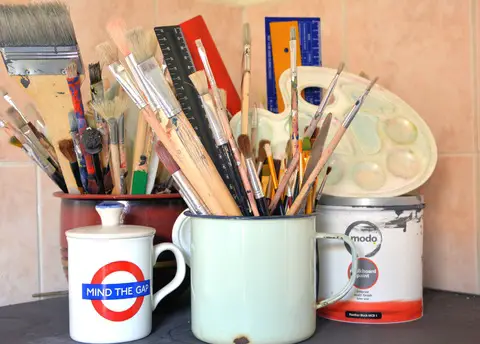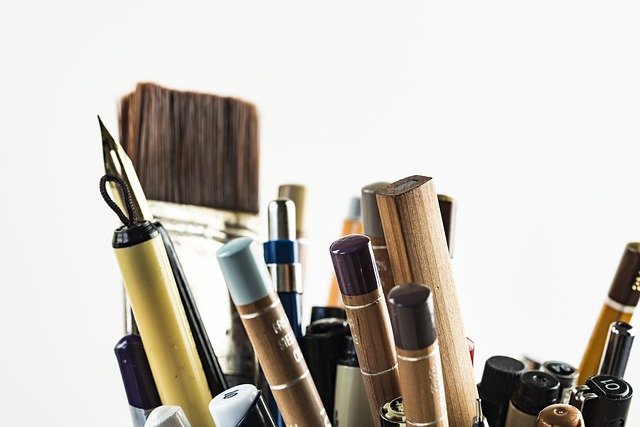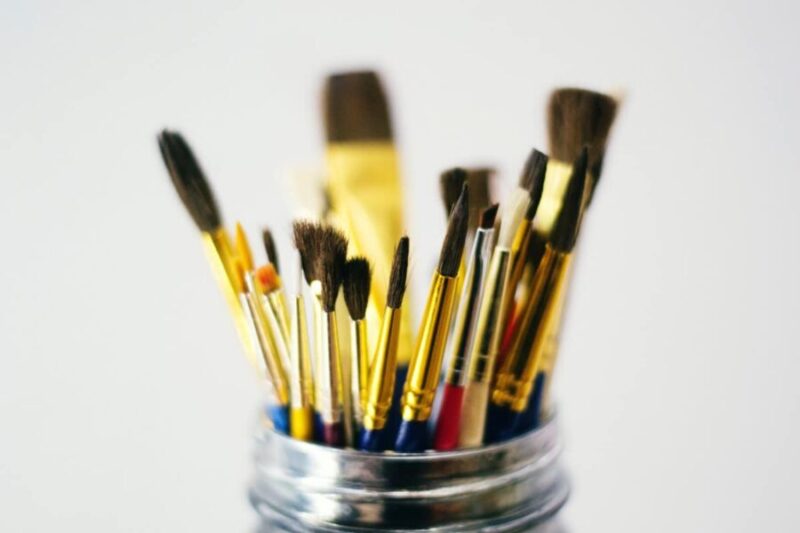The short answer is, yes, you can. In fact, you can use any paint brush for oil painting, even if they are not meant to be used for this specific purpose.
However, the problem here lies in aftercare and the usability of the paint brush for water coloring afterward.
Table of Contents
Can You Use Watercolor Brushes for Oil Painting?
Go to any art store, and you’ll be welcomed with a wide assortment of brushes. You will also find paint brushes dedicated to specific types of paints. Oil paints are used with large, long handled brushes with long hair tips.
In contrast, watercolor paint brushes are often small with shorter tips. Therefore, you may feel tempted to use watercolor brushes for fine details. But can you do that without damaging the brushes? If you have been wondering, Can You Use Watercolor Brushes for Oil Painting? Then the answer is yes. But there are certain other aspects involved as well .
.
Watercolor brushes are delicate, as using watercolors does not require much hardiness from the paint brushes. In contrast, oil-based paints often require scrubbing, soaking, and stumbling to clean. Even the surface is different. Oil painting canvases are coarser compared to watercolor papers.
So, when you use watercolor paint brushes for oil painting, the paint techniques and the coarse surface damages the delicate bristles.
An oil painting brush typically comes with a long brush handle, which makes it easier to work with. In contrast, watercolor paint brushes are shorter. So, it might get tricky when you use them to make oil paintings.
typically comes with a long brush handle, which makes it easier to work with. In contrast, watercolor paint brushes are shorter. So, it might get tricky when you use them to make oil paintings.

- Perfectly Filbert Paint Brush Set:Profession filbert paint brushes work great for oil,...
- Sizes:The set of brushes in various sizes, including size 0#,2#,4#,6#,8#,10#,12#,14#,16#. Suitable...
- Durable Structure:The artist filbert head brushes are made of high-quality soft synthetic nylon with...
Last update on 2025-06-29 / Affiliate links / Images from Amazon Product Advertising API
Cleaning the Brush
Cleaning becomes a big issue if you use the same brushes for watercolors and oil paints. When you use watercolor brushes as intended, cleaning them requires just a few swirls under clean water.
requires just a few swirls under clean water.
But oil paint can’t be cleaned with just water since the medium is oil. To clean oil-based paint, you need to use mineral spirits, solvents, paint thinner, mild soap, drying oil, linseed oil, etc. A lot of scrubbing is often involved in getting the dried paint off.
Natural hair watercolor brushes are not made to be cleaned with solvents or by harsh scrubbing. So, the cleaning process damages the bristles.
The brush may even begin to shed hairs. This happens because the cleaning liquids get inside the ferrule (the metal part between the hair and the handle) and loosen up the glue holding the hairs in place.
The Bottom Line
Given the circumstances, if you use a watercolor brush for oil painting, the brush will not be suitable for use with watercolor anymore. So, you cannot use the same brush for both.
But watercolor brushes are excellent for detailing and depositing paint with the fine point. So, you can get a superior quality one and use it exclusively for detailed work with oil colors. Try to avoid cheap brushes as they will only get too damaged to use and not hold the original shape.

Types of Paint Brushes
You can divide paint brushes into two broad areas based on the source of hair – natural and synthetic. Watercolors work the best with a natural hairbrush, though there are many synthetic ones that work fine.
For an acrylic brush, synthetic hair is more suitable. It is because acrylic paints have high alkalinity, which damages natural bristles. Synthetic ones are more chemical resistant.
Oil paints work well with both natural and synthetic bristles. So, you can get both depending on your need and budget.
Now, let’s discuss the bristle types a bit more –
Natural Hairbrushes
Natural hair from different animals has been used to make paint brushes for a long time. In comparison to synthetic brushes, they can hold more paint. This makes them preferable for oil painting, as you do not have to go back to load the brush with more color too often.
for a long time. In comparison to synthetic brushes, they can hold more paint. This makes them preferable for oil painting, as you do not have to go back to load the brush with more color too often.
They absorb water better, too. Better absorption of water makes them ideal for watercolor because it makes depositing watercolor pigments easier.
Oil brushes, acrylic brushes, watercolor brushes – we can find them all in this brush category. The con of natural hairs is that they break and shed more easily. They are more expensive, too, because sourcing the hair is costly.
It should be noted that diverse types of animal hair are suited for different applications. Some are more suitable for oil paints due to their natural structure because it helps with holding and spreading the paint.
Similarly, some are great for watercolors because they are soft, hold a lot of water, and can distribute the paint very evenly.
Below, we will highlight the two most popular natural bristle brushes for watercolor and oil color. Keep in mind that there are a lot more variants.
Sable Brush
Sable brushes are an extremely popular natural bristle brush, most used with watercolors. The sable hair comes from the fur of minks, weasels, martens, kolinskies, or ermines.
They can have different stiffness – soft, medium, and firm. As a result, you can find a sable brush for all types of paints – watercolor, oil, and acrylic brushes.
Amongst sable brushes, red sable brushes are the finest quality ones for watercolor paints. These brushes use sable hair from the tail of a weasel, where the hair naturally gets tapered near the end. They are too delicate and shouldn’t be used for oil and acrylic paint.
Hog Brush
Hog bristles are the classic material for oil paint brushes. Apart from the bristle brush we mentioned, you can find hog brushes in various shapes – such as flat brush, fan brush, filbert brush and round brush.
Ideally, a hog bristle brush is more suitable for oil paint and acrylic paint. Bristle brushes are common oil painting brushes that leave the typical brush mark you will often see in oil painting on canvas.
These marks are caused by their sharp edges caressing against the canvas every time you make a stroke. Hog bristle brushes are so common that we can guarantee that all oil painters own at least one.
Other Natural Hairbrushes
Apart from hog and sable type brushes, you can also find natural bristles from Ox hair, camel hair, squirrel tails, badger hair, pony hair and mongoose hair. They are less common, so we have not discussed them in detail.
Synthetic Hairbrushes
Most synthetic brushes are made from nylon bristles and polyester bristles. In a brush, synthetic hairs are treated to emulate natural hair properties.
A synthetic brush is suitable for use with all types of paints, be it oil paint, watercolor, or acrylic paint. Since the synthetic fibers are manufactured, the stiffness of the brush can be controlled to work with any medium.
These brushes are also more affordable. Keeping a synthetic brush clean is easier, as the brush does not have the hair structure of a natural brush. So, they are the best brushes to use for beginners.
These brushes are also less prone to getting damaged from solvents or other chemicals. So, if you want to use a watercolor painting brush for oil painting, make sure it is synthetic. That way, you have nothing to worry about, even if the paint dries on the brush.
The con of synthetic hairs is that they have a slick structure, and the natural coarse hair pattern is missing. It reduces their capability of holding paint. To combat that, you can buy special brushes made with a mix of natural and synthetic bristles.


Final Words
By now, you should have a clear idea about the answer to ‘Can I use watercolor brushes for oil painting?’ Additionally, you should also know a fair bit about paint brushes in general. I hope this knowledge has been helpful to you in choosing a brush for yourself. Now that you have decided the type of brush to get, pick it up and start painting! Don’t forget to have fun!

